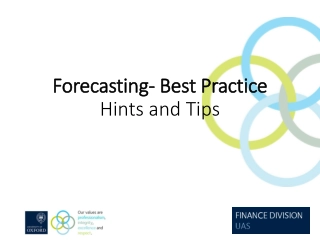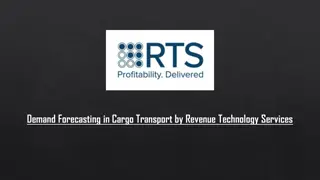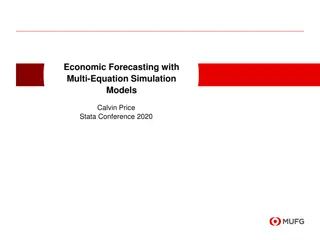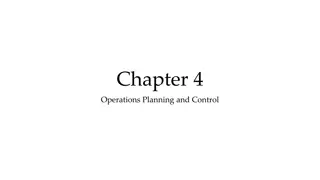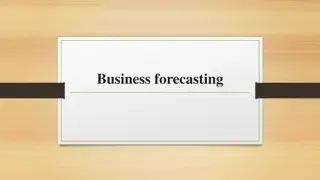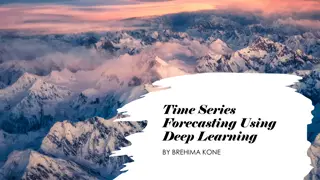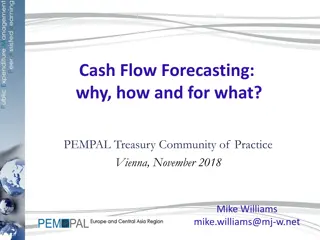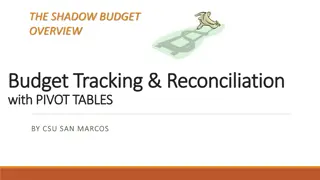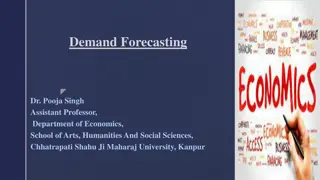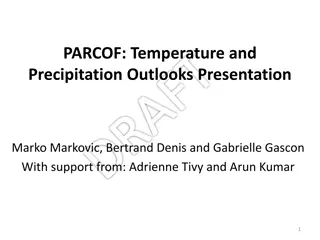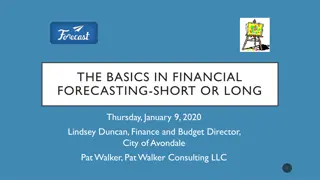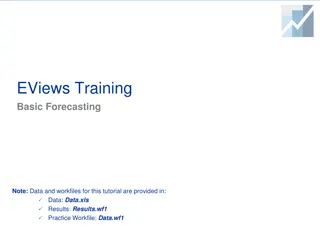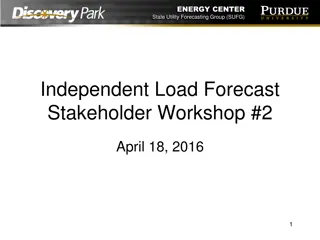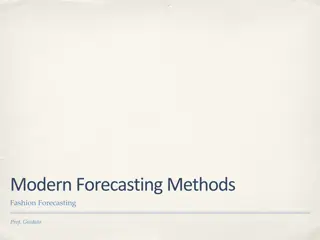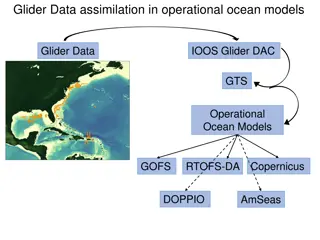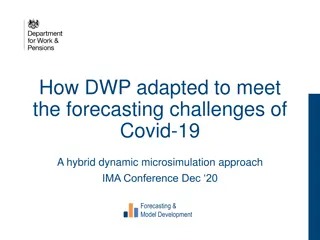Understanding the Forecasting Process with Dr. Mohammed Alahmed
Dr. Mohammed Alahmed provides a comprehensive guide to the forecasting process, covering problem definition, gathering information, model selection, evaluation, and more. The content highlights key steps such as specifying objectives, identifying time dimensions, and evaluating forecasting models for accuracy. Through detailed explanations and visuals, Dr. Alahmed simplifies complex concepts for effective forecasting strategies.
Download Presentation

Please find below an Image/Link to download the presentation.
The content on the website is provided AS IS for your information and personal use only. It may not be sold, licensed, or shared on other websites without obtaining consent from the author. Download presentation by click this link. If you encounter any issues during the download, it is possible that the publisher has removed the file from their server.
E N D
Presentation Transcript
The Forecast Process Dr. Mohammed Alahmed Dr. Mohammed Alahmed http://fac.ksu.edu.sa/alahmed alahmed@ksu.edu.sa (011) 4674108 1
Chapter Objectives Establish framework for a successful forecasting system. Introduce the trend, cycle and seasonal factors of a time series. Introduce concept of Autocorrelation and Estimation of the Autocorrelation function. Dr. Mohammed Alahmed 2
The overall forecasting process can be outlined as follows: Problem Definition Gathering Information Choosing and fitting models Using and evaluating a forecasting model Models selection Specify objectives Identify time dimensions Forecast preparation Dr. Mohammed Alahmed Models evaluation Identify what to forecast Forecast presentation Data consider- ations Tracking results 3
Problem Definition 1. Specify the objectives - How the forecast will be used in a decision context. 2. Determine what to forecast - Fore example to forecast sales one must decide whether to forecast unit sales or dollar sales, total sales, or sales by region or product line. Dr. Mohammed Alahmed 4
Gathering Information 1. Identify time dimensions The length and periodicity of the forecast. - Is the forecast needed on an annual, quarterly, monthly or daily basis, and how much time we have to develop the forecast? 2. Data consideration Quantity and type of data that are available. - Where to go to get the data? Dr. Mohammed Alahmed 5
Choosing and fitting models 1. Model selection This phase depends on the following criteria: - The pattern exhibited by the data - The quantity of historical data available - The length of the forecast horizon 2. Model evaluation Test the model on the specific series that we want to forecast. - Fit: refers to how well the model works in the set that was used to develop it. - Accuracy: refers to how well the model works in the holdout period. Dr. Mohammed Alahmed 6
Using and evaluating a forecasting model 1. Forecast preparation The result of having found model or models that you believe will produce an acceptably accurate forecast. 2. Forecast Presentation It involves clear communication. 3. Tracking results Over time, even the best models are likely to deteriorate in terms of accuracy and should be adjusted or replaced with alternative methods. Dr. Mohammed Alahmed 7
Explanatory versus Time Series forecasting 1. Explanatory models Assume that the variable to be forecasted exhibits an explanatory relationship with one or more independent variables. - For example: DCS = f (DPI, PR, Index, error) DCS = domestic car sales DPI = Disposable income PR = prime interest rate Index = University of Michigan index of consumer index. Dr. Mohammed Alahmed 8
2. Time series forecasting Makes no attempt to discover the factors affecting its behavior. Hence prediction is based ONLY on past values of a variable. The objective is to discover the pattern in the historical data series and extrapolate that pattern into the future. DCS t+1 = f (DCS t , DCS t-1, DCS t-2,.., error) Dr. Mohammed Alahmed 9
Trend, Seasonal, and Cyclical Data Patterns The data that are used most often in forecasting are time series. Time series data are collected over successive increments of time. - Example: Monthly unemployment rate, the quarterly gross domestic product, the number of visitors to a national park every year for a 30-year period. Such time series data can display a variety of patterns when plotted over time. Dr. Mohammed Alahmed 10
Data Pattern A time series is likely to contain some or all of the following components: 1. Trend 2. Seasonal 3. Cyclical 4. Irregular Dr. Mohammed Alahmed 11
Data Pattern (Trend) Trendin a time series is the long-term change in the level of the data (i.e. observations grow or decline over an extended period of time). 1. Positive trend: - When the series move upward over an extended period of time 2. Negative trend: - When the series move downward over an extended period of time 3. Stationary: - When there is neither positive or negative trend. Dr. Mohammed Alahmed 12
Data Pattern (Seasonal) Seasonalpattern in time series is a regular variation in the level of data that repeats itself at the same time every year. Examples: - Retail sales for many products tend to peak in November and December. - Housing starts are stronger in spring and summer than fall and winter. Dr. Mohammed Alahmed 13
Data Pattern (Cyclical) Cyclicalpatterns in a time series is presented by wavelike upward and downward movements of the data around the long-term trend. They are of longer duration and are less regular than seasonal fluctuations. The causes of cyclical fluctuations are usually less apparent than seasonal variations. Dr. Mohammed Alahmed 14
Data Pattern(Irregular ) Irregular pattern in a time series data are the fluctuations that are not part of the other three components These are the most difficult to capture in a forecasting model Dr. Mohammed Alahmed 15
Example1: GDP, in 1996 Dollars Dr. Mohammed Alahmed 16
Example2: Quarterly data on housing Dr. Mohammed Alahmed 17
Example3: U.S. billings of the Leo Burnet advertising agency Dr. Mohammed Alahmed 18
Data Patterns and Model Selection The pattern that exist in the data is an important consideration in determining which forecasting techniques are appropriate. To forecast stationary data; use the available history to estimate its mean value, this is the forecast for future period. The estimate can be updated as new information becomes available. The updating techniques are useful when initial estimates are unreliable or the stability of the average is in question. Dr. Mohammed Alahmed 19
Forecasting techniques used for stationary time series data are: 1. Naive methods 2. Simple averaging methods, 3. Moving averages 4. Simple exponential smoothing 5. Autoregressive moving average(ARMA) Dr. Mohammed Alahmed 20
Methods used for time series data with trend are: 1. Moving averages 2. Holt s linear exponential smoothing 3. Simple regression 4. Growth curve 5. Exponential models 6. Time series decomposition 7. Autoregressive integrated moving average (ARIMA) Dr. Mohammed Alahmed 21
For time series data with seasonal component the goal is to estimate seasonal indexes from historical data. These indexes are used to include seasonality in forecast or remove such effect from the observed value. Forecasting methods to be considered for these type of data are: 1. Winter s exponential smoothing 2. Time series multiple regression 3. Autoregressive integrated moving average (ARIMA) Dr. Mohammed Alahmed 22
Cyclical time series data show wavelike fluctuation around the trend that tend to repeat. - Difficult to model because their patterns are not stable. - Because of the irregular behavior of cycles, analyzing these type data requires finding coincidental or leading economic indicators. Dr. Mohammed Alahmed 23
Forecasting methods to be considered for these type of data are: 1. Classical decomposition methods 2. Econometric models 3. Multiple regression 4. Autoregressive integrated moving average (ARIMA) Dr. Mohammed Alahmed 24
For GDP example, which has a trend and a cycle but no seasonality, the following might be appropriate: 1. Holt s exponential smoothing 2. Linear regression trend 3. Causal regression 4. Time series decomposition Dr. Mohammed Alahmed 25
Private housing starts example have a trend, seasonality, and a cycle. The likely forecasting models are: 1. Winter s exponential smoothing 2. Linear regression trend with seasonal adjustment 3. Causal regression 4. Time series decomposition Dr. Mohammed Alahmed 26
For U.S. billings of Leo Burnett advertising example, There is a non-linear trend, with no seasonality and no cycle, therefore the models appropriate for this data set are: 1. Non-linear regression trend 2. Causal regression Dr. Mohammed Alahmed 27
Autocorrelation Correlation coefficient is a summary statistic that measures the extent of linear relationship between two variables. As such they can be used to identify explanatory relationships. Autocorrelation is comparable measure that serves the same purpose for a single variable measured over time. Dr. Mohammed Alahmed 28
In evaluating time series data, it is useful to look at the correlation between successive observations over time. This measure of correlation is called autocorrelation and may be calculated as follows: + = = n k y 1 n ( )( ) y y y y Dr. Mohammed Alahmed t t k 1 t k r = t 2 ( ) y t rk = autocorrelation coefficient for a k period lag. = mean of the time series. yt = Value of the time series at period t. y t-k = Value of time series k periods before period t. y 29
Autocorrelation coefficient for different time lags can be used to answer the following questions about a time series data: 1. Are the data random? - In this case the autocorrelations between yt and y t-k for any lag are close to zero. The successive values of a time series are not related to each other Dr. Mohammed Alahmed 30
2. Is there a trend? If the series has a trend, yt and yt-k are highly correlated. The autocorrelation coefficients are significantly different from zero for the first few lags and then gradually drops toward zero. The autocorrelation coefficient for the lag 1 is often very large (close to 1). A series that contains a trend is said to be non-stationary. Dr. Mohammed Alahmed 31
3. Is there seasonal pattern? If a series has a seasonal pattern, there will be a significant autocorrelation coefficient at the seasonal time lag or multiples of the seasonal lag. The seasonal lag is 4 for quarterly data and 12 for monthly data. 4. Is it stationary? A stationary time series is one whose basic statistical properties, such as the mean and variance, remain constant over time. Autocorrelation coefficients for a stationary series decline to zero fairly rapidly, generally after the second or third time lag. Dr. Mohammed Alahmed 32
To determine whether the autocorrelation at lag k is significantly different from zero, the following hypothesis and rule of thumb may be used: H0: k= 0, Ha: k 0 Reject H0 if Dr. Mohammed Alahmed 2 rk n Where n is the number of observations. This rule of thumb is for = 5% 33
The hypothesis test developed to determine whether a particular autocorrelation coefficient is significantly different from zero is: Hypotheses: H0: k= 0, Ha: k 0 Test Statistic: r t =1 Dr. Mohammed Alahmed 0 k n k Reject H0 if or t t t t ; 2 ; 2 n k n k 34
The plot of the autocorrelation Function (ACF) versus time lag is called Correlogram. The horizontal scale is the time lag The vertical axis is the autocorrelation coefficient. Patterns in a Correlogram are used to analyze key features of data. Dr. Mohammed Alahmed 35
Example1: Mobil Home Shipment Correlograms for the mobile home shipment Note that this is quarterly data 1 Dr. Mohammed Alahmed 0.8 0.6 ACF 0.4 Upper Limit 0.2 Lower Limit 0 1 2 3 4 5 6 7 8 9 10 11 12 -0.2 -0.4 36
Example2: Japanese exchange Rate As the world s economy becomes increasingly interdependent, various exchange rates between currencies have become important in making business decisions. For many U.S. businesses, The Japanese exchange rate (in yen per U.S. dollar) is an important decision variable. A time series plot of the Japanese-yen U.S.-dollar exchange rate is shown below. On the basis of this plot, would you say the data is stationary? Is there any seasonal component to this time series plot? Dr. Mohammed Alahmed 37
Japanese Exchange Rate 180 Exchange Rate ( yen per U.S. dollar) 160 140 120 Dr. Mohammed Alahmed 100 EXRJ 80 60 40 20 0 0 5 10 15 20 25 30 Months 38
Here is the autocorrelation structure for EXRJ. With a sample size of 24, the critical value is Obs 1 2 3 4 5 6 7 8 9 10 11 12 ACF .8157 .5383 .2733 .0340 -.1214 -.1924 -.2157 -.1978 -.1215 -.1217 -.1823 -.2593 2 2 = = . 0 408 24 n Dr. Mohammed Alahmed This is the approximate 95% critical value for rejecting the null hypothesis of zero autocorrelation at lag K. 39
The Correlograms for EXRJ is given below 1 0.8 0.6 ACF 0.4 Dr. Mohammed Alahmed Upper Limit 0.2 Lower Limit 0 1 2 3 4 5 6 7 8 9 10 11 12 -0.2 -0.4 -0.6 Since the autocorrelation coefficients fall to below the critical value after just two periods, we can conclude that there is no trend in the data. 40
To check for seasonality at = .05 The hypotheses are: H0; 12 = 0 Test statistic is: Ha: 12 0 n 0 2595 . r = = = . 0 899 k t 1 / 1 24 12 k Reject H0 if Dr. Mohammed Alahmed or t t t t ; 2 ; 2 n k n k = = . 2 179 t 12 t ; 2 . 0 ; 025 n k Since = . 0 = . 2 899 179 t 12 t . 0 ; 025 We do not reject H0 , therefore seasonality does not appear to be an attribute of the data 41
ACF of Forecast Error The autocorrelation function of the forecast errors is very useful in determining if there is any remaining pattern in the errors (residuals) after a forecasting model has been applied. This is not a measure of accuracy, but rather can be used to indicate if the forecasting method could be improved Dr. Mohammed Alahmed 42


